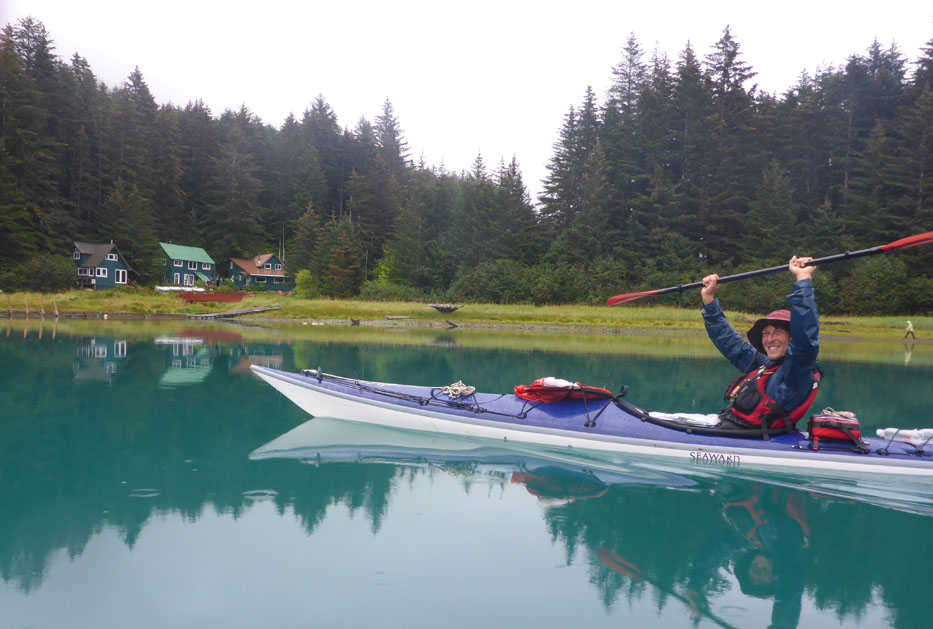A Gustavus-grown scientist recently completed a 2,000 mile journey by foot and kayak from Stanford, California to Southeast Alaska, aiming to raise money for a science institute he plans at the Inian Islands location known as “the Hobbit Hole.”
Zach Brown, who graduated from Stanford University’s Department of Environmental Earth System Science with a Ph.D., began walking north April 25.
He started off in style: when it got to be time to set up camp his first night, he was passing through an affluent section of San Francisco. He knocked on the door of a nearby house and explained, to the woman who answered, his trek to bring awareness to the Inian Islands Institute, which its founders see as “an ecological field school like no other, bringing students for wilderness immersion courses in Southeast Alaska focused on the rich local ecology and our place within it.” He asked to camp on her lawn.
She told him no and closed the door. He moved on. Then she called the cops on him.
Most interactions along the way have been much more friendly. Brown, a self-described gregarious person, said one of the most challenging aspects of the trip was being alone for the majority of the 113 days it took him. In that way, he said, some of the trip’s most memorable moments had to do with people: The caretaker of Addenbroke Lighthouse, in British Columbia, invited him to stay for the night; two fishermen from Sitka fed him venison burgers and fresh prawns.
Along the way, he stopped at the Salmon Coast Field Station in British Columbia.
“It is a very close analogue of the Hobbit Hole: small-scale, off-the-grid, beautiful,” he said.
His two favorite parts of the trip, he said, were hiking in Redwood National Park, through old-growth redwood trees, and paying a visit to the White Sulfur Hot Springs on Chichagof Island. Over the course of the trip, he passed, in one way or another, through most of the West Coast’s coastal temperate rainforest.
The best part of the trip, however, was his arrival at his final destination.
“…The biggest highlight had to be arriving at the Hobbit Hole, the culmination of the long journey. That night, a bunch of people from Gustavus came out there in their boats and we had a wonderful party, and a rare evening of sunshine. It was surreal and magical for me,” he wrote in an email.
Now that the journey is finished, he plans more work on the Inian Islands Institute.
Brown and those he’s working with — founders include Lauren Oakes, Aaron Strong, and Lida Teneva, all Ph.D. candidates at Stanford who have done work in or relevant to Alaska — have “our website, video, logo, advisory council, business model, a fantastic Stanford course under our belts, and more courses in the pipeline for next summer,” he wrote. “But we are still looking for our “angel” to help us purchase the Hobbit Hole property before it falls into the wrong hands — that is priority number 1 for us!”
They raised about $25,000 through a fundraiser over the winter. With that money, they got a professional appraisal and did some media work, he said. But right now, they’re mainly focused on looking for their angel donor.
The property is listed for $2 million.
Brown plans to be an instructor at the institute. Over the winter, he’ll be organizing courses and visiting researchers and “generally furthering my education about the ecology and practical skills and living in this area, so that I will be as able an instructor at Inian as I can possibly be,” he said.
As he wrote on his blog about the journey’s conclusion: “Finally I gathered myself to say a few words. They might’ve been totally incoherent — something about how the trek was long, not always fun, not always safe, but it was worth every mile just for this moment. And I said something about the Hobbit Hole, and our dream to use that special homestead in the wilderness to create a public institute for education and research. And then some thank-yous, because while the trek might’ve been under my own power, I certainly wasn’t on my own out there.”

